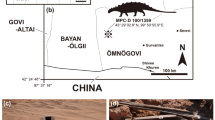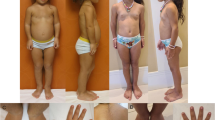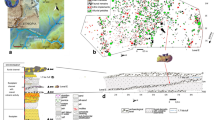Abstract
There have been numerous reports of pathological conditions in the hominid fossils, but these have only involved trauma or age-related deterioration in the health of otherwise normal individuals1–4. Here we describe a skeleton of a young male from Riparo del Romito in Calabria, dated to the Epi-Gravettian of southern Italy. The preserved skeletal elements show that this individual (Romito 2) had the skull and long-bone morphology consistent with a mesomelic form of dwarfism, most probably the autosomal recessive disorder acromesomelic dysplasia5–8. Generally recognized at birth, persons with acromesomelic dysplasia usually have normal intelligence and are free of serious medical problems. However, growth deficiency is severe (adult height typically is 110–120 cm) and mobility at the elbows is restricted. These physical impairments would have greatly interfered with the individual's participation in subsistence activities and would have been a substantial handicap in a nomadic hunting and gathering group. Thus, besides being the earliest known case of dwarfism in the human record, this skeleton provides evidence of tolerance of, and care for, a severely deformed individual in the Palaeolithic.
This is a preview of subscription content, access via your institution
Access options
Subscribe to this journal
Receive 51 print issues and online access
$199.00 per year
only $3.90 per issue
Buy this article
- Purchase on Springer Link
- Instant access to full article PDF
Prices may be subject to local taxes which are calculated during checkout
Similar content being viewed by others
References
1. DeLumley, M-A. Etudes Quat. 2, 1-626 (1973). 2. Dastague, J. & deLumley, M-A. in La Prehistoire Francaise (ed. deLumley, H.) 612-622 (CNRS, Paris, 1976). 3. Corrain, C., Grazati, G. & Leonardi, P. Preist. Alpina 12, 175-212 (1976). 4. Pittard, E. & Sauter, M-R. Archs Swisses Anthrop. gen. XI(2), 1-197 (1946). 5. Maroteaux, P., Martinelli, B. & Campailla, E. La Presse Med. 79, 1839-1842 (1971). 6. Langer, L. O. et al. Am. J, med. Genet. 1, 87-100 (1977). 7. Langer, L. O. & Garrett, R. O. Radiology 137, 349-355 (1980). 8. Rimoin, D. L. Adv. hum. Genet. 5, 1-118 (1975). 9. Graziosi, P. Riv. Sci. preist. 18, 315 (1963). 10. Graziosi, P. Riv. Sci. preist. 18, 301-302 (1964). 11. Messeri, P. Atti X Riun. scient. 1st. Ital. Preist. Protost. 301-307 (1966). 12. Alessio, M., Bella, F. & Cortesi, C. Radiocarbon 8, 401-412 (1966). 13. Prayer, D. W. Am. Anthrop. 83, 53-73 (1981). 14. Vallois, H. V. & deFelice, S. Arch. VInst. Paleont. hum. 37, 1-193 (1937). 15. Riquet, R. in L'Homme, de Cro-Magnon (eds Camps, G. & Olivier, G.) 37-58 (Arts et Metiers Graphiques, Paris, 1970). 16. Farkas, G. & Lengyel, I. Mora Ferenc Muzeum Evkonyve, 199-207 (1971/1972). 17. GJadykowska-Rzeczycka, J. Ossa 7, 71-74 (1980). 18. Larje, R. Arch. Environ. 4, 259-271 (1985). 19. Johnston, F. E. Clin. Pediat. 2, 703-708 (1963). 20. Ortner, D. J. & Putschar, W. J. Smithson. Contr. Anthrop. 28 1-479 (1981). 21. Wobst, H. M. in The Demographic Evolution of Human Populations (eds Ward, R. H. & Weiss, K. M.) 49-58 (Academic, New York, 1976). 22. Ablon, J. Little People in America (Praeger, New York, 1984). 23. M0rch, E. T. Chondrodystrophic Dwarfs in Denmark (Munksgaard, Copenhagen, 1941). 24. Graziosi, P. in Misceldnea en Homenaje al Abate Henri Breuil (ed. Perello, E. R.) 457-466 (Deputation Provincial, Barcelona, 1964). 25. Graziosi, P. LArte Preistorica in Italia (Sansoni, Firenze, 1973).
Author information
Authors and Affiliations
Rights and permissions
About this article
Cite this article
Frayer, D., Horton, W., Macchiarelli, R. et al. Dwarfism in an adolescent from the Italian late Upper Palaeolithic. Nature 330, 60–62 (1987). https://doi.org/10.1038/330060a0
Received:
Accepted:
Issue Date:
DOI: https://doi.org/10.1038/330060a0
This article is cited by
-
La piconodisostosi: un modello naturale per la terapia dell’osteoporosi
L'Endocrinologo (2024)
-
Primate thanatology and hominoid mortuary archeology
Primates (2020)
Comments
By submitting a comment you agree to abide by our Terms and Community Guidelines. If you find something abusive or that does not comply with our terms or guidelines please flag it as inappropriate.



